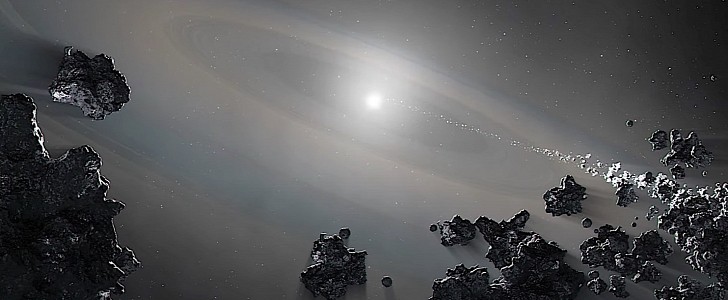Cosmic cannibalism. This is how a research group comprising scientists from UCLA, the University of California San Diego, and the Kiel University in Germany are calling what they’ve seen happening in a planetary system governed by a star called G238-44.
G238-44 is presently a white dwarf. That’s generally what’s left of a star not unlike our Sun after it dies, but not before it expands, destroys planets, then stops burning fuel through nuclear fusion, and ultimately sheds its outer layers. When something like this happens, the effects on the surrounding planetary system are dramatic to say the least, and pretty much impossible to comprehend with our puny human minds.
But we can at least get a sense of what that’s like, thanks to a new research presented this week during an American Astronomical Society (AAS) conference by representatives of said group.
Scientists looked at data collected some time ago with the help of the Hubble Space Telescope, the Far Ultraviolet Spectroscopic Explorer (FUSE), and the Keck Observatory's High Resolution Echelle Spectrometer (HIRES).
This data allowed humans to observe for the first time ever “a white dwarf star that is consuming both rocky-metallic and icy material, the ingredients of planets.”
We’re told the observations were made some 100 million years after G238-44 turned into a white dwarf, and even now there were signs of the star simultaneously pulling in “debris from both the system's inner and outer reaches.”
Scientists have calculated that the mass of material consumed by the star in this phase does not exceed the mass of an asteroid or small moon, but there was something else that caught their eye: the presence of two objects, not included in the measurement, that seem to be rich in metal, the first, and an icy body, the other.
This breakthrough makes scientists believe they’re actually looking at a cross-section of planetary formation. They’ve discovered the presence of a lot of iron, which makes up terrestrial planets like Earth, Venus, Mars, and Mercury, but also a lot of nitrogen that suggest the presence of ice bodies.
What’s even scarier is that our Sun, and the system that spins around it, will most likely have the same fate. The star will go down the white dwarf path in about five billion years, completely shredding the first three planets, Mercury, Venus, and Earth, during its red giant phase. Check out the video below for a frightening insight into that.
But we can at least get a sense of what that’s like, thanks to a new research presented this week during an American Astronomical Society (AAS) conference by representatives of said group.
Scientists looked at data collected some time ago with the help of the Hubble Space Telescope, the Far Ultraviolet Spectroscopic Explorer (FUSE), and the Keck Observatory's High Resolution Echelle Spectrometer (HIRES).
This data allowed humans to observe for the first time ever “a white dwarf star that is consuming both rocky-metallic and icy material, the ingredients of planets.”
We’re told the observations were made some 100 million years after G238-44 turned into a white dwarf, and even now there were signs of the star simultaneously pulling in “debris from both the system's inner and outer reaches.”
Scientists have calculated that the mass of material consumed by the star in this phase does not exceed the mass of an asteroid or small moon, but there was something else that caught their eye: the presence of two objects, not included in the measurement, that seem to be rich in metal, the first, and an icy body, the other.
This breakthrough makes scientists believe they’re actually looking at a cross-section of planetary formation. They’ve discovered the presence of a lot of iron, which makes up terrestrial planets like Earth, Venus, Mars, and Mercury, but also a lot of nitrogen that suggest the presence of ice bodies.
What’s even scarier is that our Sun, and the system that spins around it, will most likely have the same fate. The star will go down the white dwarf path in about five billion years, completely shredding the first three planets, Mercury, Venus, and Earth, during its red giant phase. Check out the video below for a frightening insight into that.








